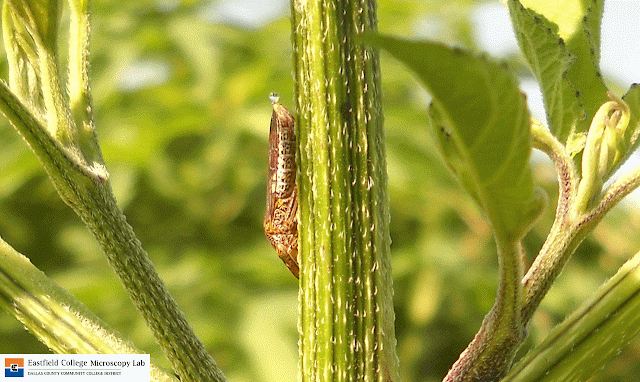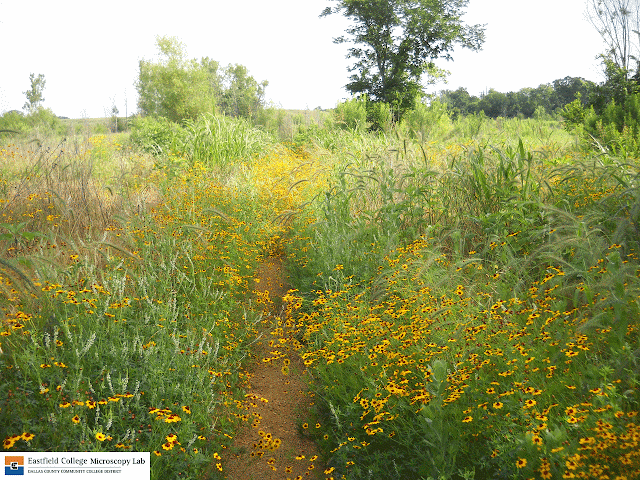June 14, 2013
Back at the Trinity River Audubon Center off of I-45 and Loop 12 just a few minutes south of downtown Dallas.
Trinity River Audubon Center
6500 Great Trinity Forest Way (formerly 6500 S. Loop 12)
Dallas, TX 75217
214-398-TRAC (8722)
The location I found today is not actually on the trail map. It is on a mowed trail that begins at the parking lot.

This is an excellent location with many tall plants (still green because of the rain we are having this month). the trail runs approximately north and south which puts one side of the trail in sun and the other in shade.
I found many young Argiope spiders on webs with stabilimenta. These are all female, about 6, and I hope to watch them through out the summer to see when they make egg sacs. Because they are located so closely together it seems reasonable that they are probably sisters from the same egg sac.
Eastfield College has a gene sequencer and it would be an excellent project to sequence some genes and see if this is true.
Argiope positioned on her stabilimenta.
A closer view of the spider.
Another Argiope female, but with a different stabilimenta pattern. One theory is that by positioning herself on the stabilimenta, the spider becomes less visible to predators such as birds.
I know that the male Argiope are much smaller than the females. I found several of these smaller webs with stabilimenta that I thought might belong to males, but have yet to find one.
At one point I saw a very small spider moving quickly across this web - very quickly. As I watched the spider moved to the top of the web and then ballooned away.
Ballooning is a process that spiderlings use to disperse. They climb to a high branch or spot and begin to release a silk thread which is picked up by the wind. When they get enough silk out it lifts them into the air where they will float to a new location.
I hadn't noticed the ballooning silk so I suspect the little spider was being pulled across the web as much as crawling.
Here is another cobweb spider which has formed a web between two leaves.
I found lots of snout beetles on many of the taller plants. These guys were ridiculously easy to capture because of a defensive behavior. When disturbed they simply let go of the leaf and fall. All I had to do was open the collecting jar, put it under the leaf, and poke the beetle causing it to fall into the jar.
These little guys are amazingly tough as I found out when I tried to pin them. I couldn't even get their legs to move laterally.
Leica S8AP0 Dissecting Scope
Close up of eye. There are slits in the proboscis for the antennae to fold into.
Some heavy duty tarsal claws.
Hatachi S-3400N Scanning Electron Microscope

Head and thorax. You can clearly see the slit for the antenna and the large tarsal claws. [20x]
The eyes have what appears to be eyelashes even though this animal does not blink its eyes. Notice the Y-shaped hairs to the right. [110x]
Ommatidia with surrounding rod shaped structures. [1,900x]
More of the bacteria-like structures in the hairs above the eye. Could be some plant material or residue. [400x]
Note: David H. Kattes in his book Insects of Texas states that order Homoptera has been absorbed into order Hymenoptera.
Kattes, David H. Insects of Texas. College Station: Texas A&M UP, 2009. Print.
Close up of the bottom hopper from the image above.
Close up of the top hopper in the previous image.
Leica S8AP0 Dissecting Scope
Back in the lab.
Collected insect in the lab.
This is the flower of the Illinois Bundle Flower - Desmanthus illinoesis. The fruit of this wildflower can be seen in the June 4 blog.
From Wildflowers of Texas - "These clusters are much sought for use in dried arrangements. High in protein, this plant is considered one of our most important native legumes, for livestock and wildlife. Readily eaten by them, it is an excellent range-condition indicator."
Ajilvsgi, Geyata. Wildflowers of Texas. Fredericksburg: Shearer Publishing, 1984. Print. Illinois Bundleflower - Desmanthus illinoensis P. 57
I welcome your comments on this blog - really - I mean it.
 All images are licensed under Creative Commons Attribution-NonCommercial 3.0 Unported (CC BY-NC 3.0)
All images are licensed under Creative Commons Attribution-NonCommercial 3.0 Unported (CC BY-NC 3.0)
Feel free to use, copy, or edit as you see fit, but be sure to give attribution to Eastfield College, Mesquite, TX. Images may not be sold.












































